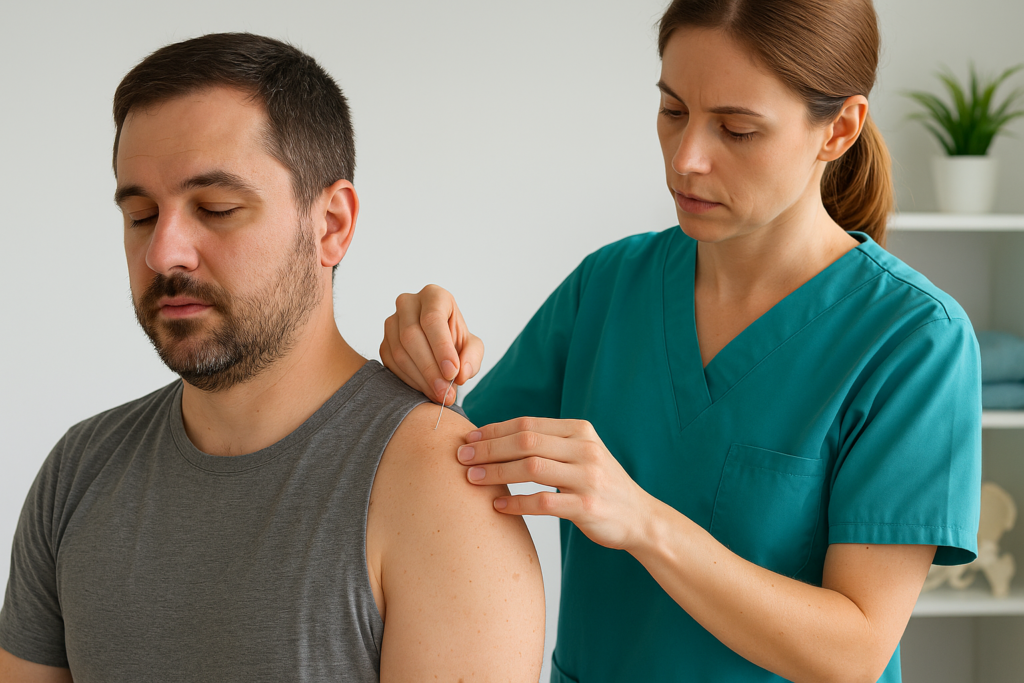
Muscle pain doesn’t discriminate. Whether it stems from heavy training or sitting at a desk for hours, tightness, soreness and reduced mobility are part of daily life for many Australians. One method increasingly being used to manage this discomfort is dry needling a treatment that’s gaining popularity among both elite athletes and everyday workers looking for muscle relief. But what is dry needling, and why are so many turning to it for help?
What Is Dry Needling and How Is It Different from Acupuncture?
Dry needling is a modern clinical treatment that involves inserting fine, sterile needles into myofascial trigger points tight knots in muscle tissue that can cause pain and restrict movement. It’s primarily used by trained health professionals such as osteopaths, physiotherapists, and chiropractors as part of a broader musculoskeletal treatment plan.
Despite visual similarities, dry needling is not acupuncture. While acupuncture is rooted in traditional Chinese medicine and based on meridian theory, dry needling is grounded in Western anatomy and evidence-based practice. The goal isn’t to restore energy flow but to release muscle tension, reduce pain, and improve function.
If you’re still unsure about the mechanics and effects of this therapy, this detailed breakdown of What is dry needling at Blackwood Osteopathy explains how the treatment fits within osteopathic care and what you might expect in a session.
How Athletes Use Dry Needling for Faster Recovery
For athletes, recovery is as crucial as training. When repetitive strain, muscle fatigue, or overuse injuries occur, dry needling offers targeted relief. By penetrating directly into trigger points, the treatment helps reduce muscle tightness, increase blood flow, and improve range of motion. For example, a long-distance runner struggling with tight calves or a tennis player experiencing shoulder tension may benefit from a few carefully placed needles to speed up healing and reduce inflammation.
Professional sports physiotherapists often combine dry needling with other recovery tools like massage, stretching, or strengthening exercises. The treatment is also common among amateur athletes who seek fast relief between training sessions or after competitions.
The growing popularity of recovery-focused methods like this is evident in online forums and sports and fitness discussions on Storeboard, where athletes share experiences, tips, and recommendations for managing common injuries.
Why Office Workers Are Also Booking In
While athletes are often the face of recovery treatments, office workers are increasingly turning to dry needling to relieve tension from desk-bound routines. Hours of poor posture, minimal movement, and screen fatigue can result in neck stiffness, upper back pain, and tension headaches.
Dry needling targets these specific muscle areas commonly the trapezius, levator scapulae, and rhomboids to reduce that deep-seated ache that stretching alone may not resolve. Combined with ergonomic adjustments and simple mobility breaks, this treatment may help prevent chronic pain from setting in.
In the broader health and wellness community on Storeboard, users have shared how treatments like dry needling support not just physical relief but mental focus and general wellbeing in sedentary work environments.
What to Expect from a Dry Needling Session
A typical dry needling session begins with an assessment of your posture, range of motion, and problem areas. The practitioner locates trigger points tight bands of muscle and inserts very fine needles into them. Most people feel a slight pinch, followed by a twitch response or mild ache as the muscle relaxes. The sensation isn’t usually painful but may feel unfamiliar.
Sessions may last anywhere from 15 to 30 minutes, depending on the number of areas treated. It’s common to feel some post-treatment soreness similar to the feeling after a strong massage which usually resolves within 24–48 hours. Many people notice improved movement or reduced pain after just one session, though multiple treatments may be recommended for lasting results.
Qualified dry needling practitioners are typically trained in anatomy, infection control, and manual therapy techniques. Always choose a registered healthcare provider with experience in musculoskeletal conditions.
Does It Really Work? Evidence and Anecdotes
While dry needling is still being studied, several clinical trials suggest it may help reduce pain intensity and improve mobility particularly in people with chronic musculoskeletal issues. The technique has shown promise in treating neck pain, tension headaches, shoulder injuries, and lower back discomfort.
Beyond research, anecdotal support for dry needling is widespread. Many athletes credit it with helping them return to training faster. Office workers speak of surprising relief after years of stiffness. While it’s not a magic fix, its targeted approach and rapid results make it an attractive option for many.
Of course, not every condition is suitable for dry needling. It may not be appropriate for those with bleeding disorders, certain medical implants, or severe needle sensitivity. A thorough consultation with a practitioner is essential before beginning treatment.
Choosing the Right Practitioner for You
With dry needling now offered in many health clinics across Australia, choosing the right practitioner matters. Look for someone who is fully qualified in manual therapy and has training specifically in dry needling. Reviews, clinic credentials, and direct recommendations can also guide your decision.
Ask questions like:
- What training have you completed in dry needling?
- What kind of conditions do you usually treat?
- How many sessions do you recommend, and why?
If you’re based in South Australia or nearby and want to learn more before booking, the information provided on What is dry needling at Blackwood Osteopathy may be a good starting point for understanding whether the treatment suits your needs.
You can also browse the Local Business Directory on Storeboard to find clinics offering dry needling services near you.
Final Thoughts: Beyond Trends, Toward Real Relief
Dry needling may sound clinical, but its results are being felt in real ways from easing a sore shoulder after a weekend of gardening to helping a sprinter get back on the track. As awareness grows and more people explore manual therapies, this technique is likely to remain a go-to option for muscular recovery and targeted pain relief.